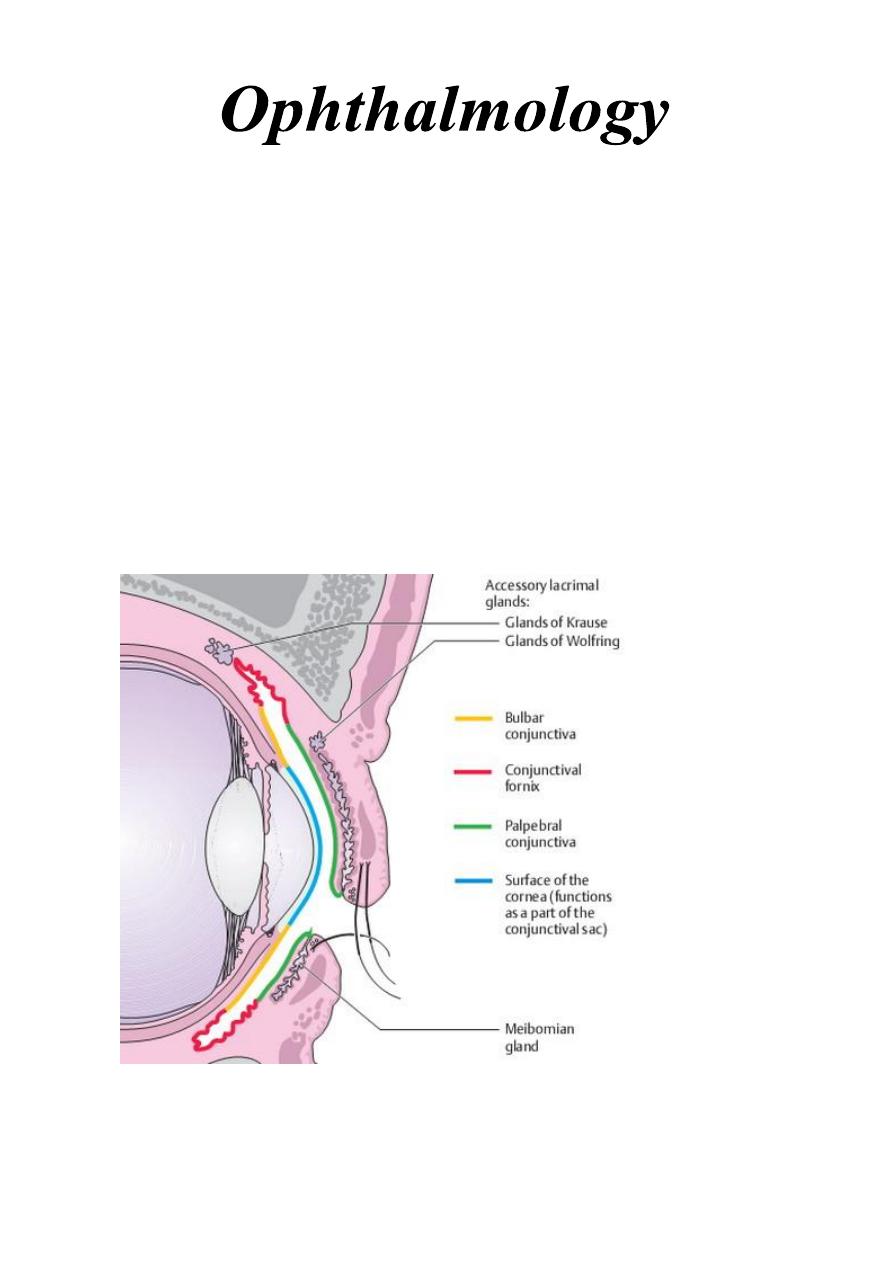
1
طب بغداد
2015-2016
Disorders of the conjunctiva
Applied anatomy:
The conjunctiva is a transparent mucous membrane lining the inner surface of the
eyelids and the surface of the globe as far as the limbus. It is richly vascular, supplied
by the anterior ciliary and palpebral arteries. There is a dense lymphatic network,
with drainage to the preauricular and submandibular nodes corresponding to that of
the eyelids. It has a key protective role, mediating both passive and active immunity.
Clinically, it is subdivided into the following:
1 The palpebral conjunctiva starts at the mucocutaneous junction of the lid
margins and is firmly attached to the posterior tarsal plates. The underlying tarsal
blood vessels can be seen passing vertically from the lid margin and fornix.
2 The forniceal conjunctiva is loose and redundant and may be thrown into folds.
3 The bulbar conjunctiva covers the anterior sclera and is continuous with the
corneal epithelium at the limbus.
Lecture: 6 & 7

2
Histology:
Conjunctiva is consists of two layers:
1 The epithelium is non-keratinizing and around five cell layers deep (Fig. 5.1).
Basal cuboidal cells evolve into flattened polyhedral cells before they are shed
from the surface. Goblet cells are located within the epithelium and are densest
inferonasally and in the fornices.
2 The stroma (substantia propria) consists of richly vascularized loose
connective tissue. The adenoid superficial layer does not develop until about 3
months after birth, hence the inability of the newborn to produce a follicular
conjunctival reaction. The deep fibrous layer merges with the tarsal plates. The
accessory lacrimal glands of Krause and Wolfring are located deep within the
stroma. Mucus from the goblet cells and secretions from the accessory lacrimal
glands are essential components of the tear film.
The conjunctiva containing the following secreting glands and cells:
1- Mucin secretors: They are of three types:
a- Goblet cells.
b- Crypts of Henle: Found at upper part of tarsal plate.
c- Glands of Manz.
Function: Lubrication.
In destructive disorders e.g. autoimmune conjunctivitis (cicatricial pamphygoid or
steven johnsen syndrome), there is decrease in number of cells lead to decrease
mucin secretion, while chronic inflammatory disorders increases the number of the
cells with increase mucin secretion e.g. vernal keratoconjunctivitis.
2- Accessory lacrimal glands:
a- Krause.
b- Wolfring.
They are found deep in Stroma mainly at fornices.
Clinical Evaluation of Conjunctival inflammation:
The differential diagnosis of conjunctival inflammation depends on:
1- Symptoms:
Conjunctivitis: Has non-specific symptom such as: lacrimation, irritation, stinging,
burning and photophobia (visual acuity is not affected as conjunctiva is away from
visual axis and it is not a part of the optical system of the eye).
If it is associated with keratitis, there will be pain, foreign body sensation and
sometimes blurred vision (as the cornea is affected).
In allergic conditions, the hallmark is itching, which also occurs in blepharitis
(inflammation of lid margin) and keratoconjunctivitis sicca.
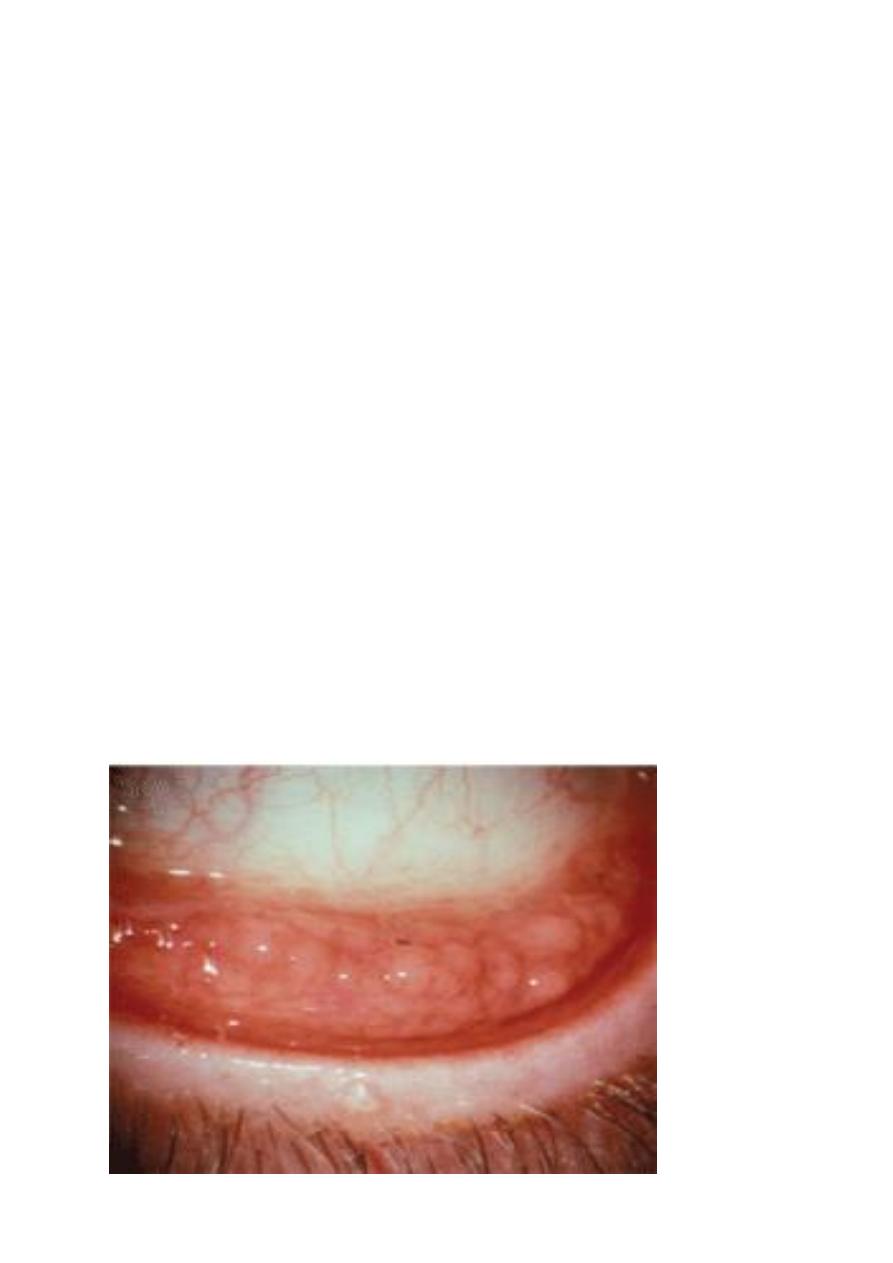
3
2- discharge:
It is exudates filtered through conjunctival epithelium from dilated blood vessels
with additional epithelial debris, mucus and aqueous tear.
Discharge can be of the following types:
a- Watery: Serous exudates and reflexly secreted tear. e.g.
- Acute viral conjunctivitis.
- Allergic conjunctivitis.
b- Mucoid: usually seen in chronic inflammatory conditions when mucin
secretion is increased: e.g.
- Vernal conjunctivitis.
- Keratoconjunctivitis sicca.
c- Purulent: e.g. in Severe acute bacterial conjunctivitis.
d- Mucopurulent: e.g. - Mild bacterial conjunctivitis.
- Chlamydial infections.
3- Conjunctival Appearance:
a- Conjunctival injection: Can give a clue in diagnosis although it is a non-
specific feature, in which, the beefy-red conjunctiva suggests a bacterial cause
(especially in the inferior fornix) while fish meat color suggests allergy.
b- Subconjunctival haemorrhages: mostly associated with:
- Viral infection, e.g.: Adenovirus, Acute haemorrhagic conjunctivitis.
- Bacterial infection, e.g. Streptococcus pneumoniae.
c- Follicular reaction: It is seen by magnification of slit-lamp. It is consists of
hyperplasia of lymphoid tissue within the stroma, commonly occurs in inferior
forniceal conjunctiva.
Clinically: It is seen as multiple, discrete, slightly elevated lesions, reminiscent of
small grains of rice. Each follicle is encircled (surrounded) by tiny blood vessels.
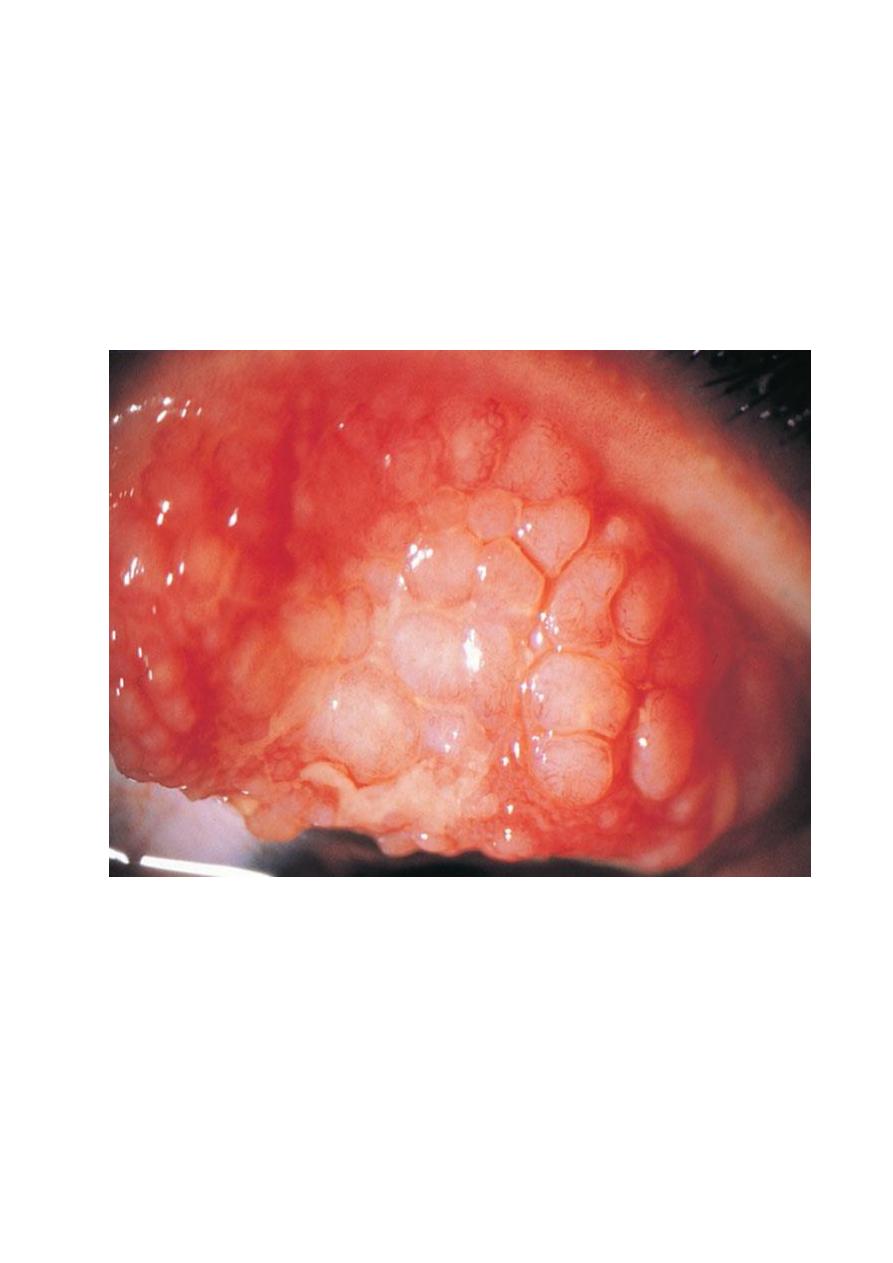
4
* The main causes of follicular reaction are (differential diagnosis):
- Viral infections.
- Chlamydial infections.
- Parinaud oculoglandular syndrome.
- Hyper sensitivity to topical medications.
d- Papillary reaction: It is of less diagnostic value than follicular reaction. It is
hyperplasia of conjunctival epithelium (surrounding a core of blood vessels)
thrown into numerous folds or projections. Commonly occurs in the upper
palpebral conjunctiva.
Clinically seen as a fine mosaic-like pattern of elevated polygonal hyperemic areas
separated by paler channels.
Main causes are:
- Chronic blepharitis.
- Allergic conjunctivitis.
- Bacterial conjunctivitis.
- Contact lens-related problems.
e- Oedema (chemosis): whenever the conjunctiva is severely inflamed. It is
transudation of fibrin and protein-rich fluid through the walls of the damaged
blood vessels producing a translucent swelling of the conjunctiva.
f- Scarring: its causes are:
- Trachoma.
- Ocular cicatricial pemphigoid.
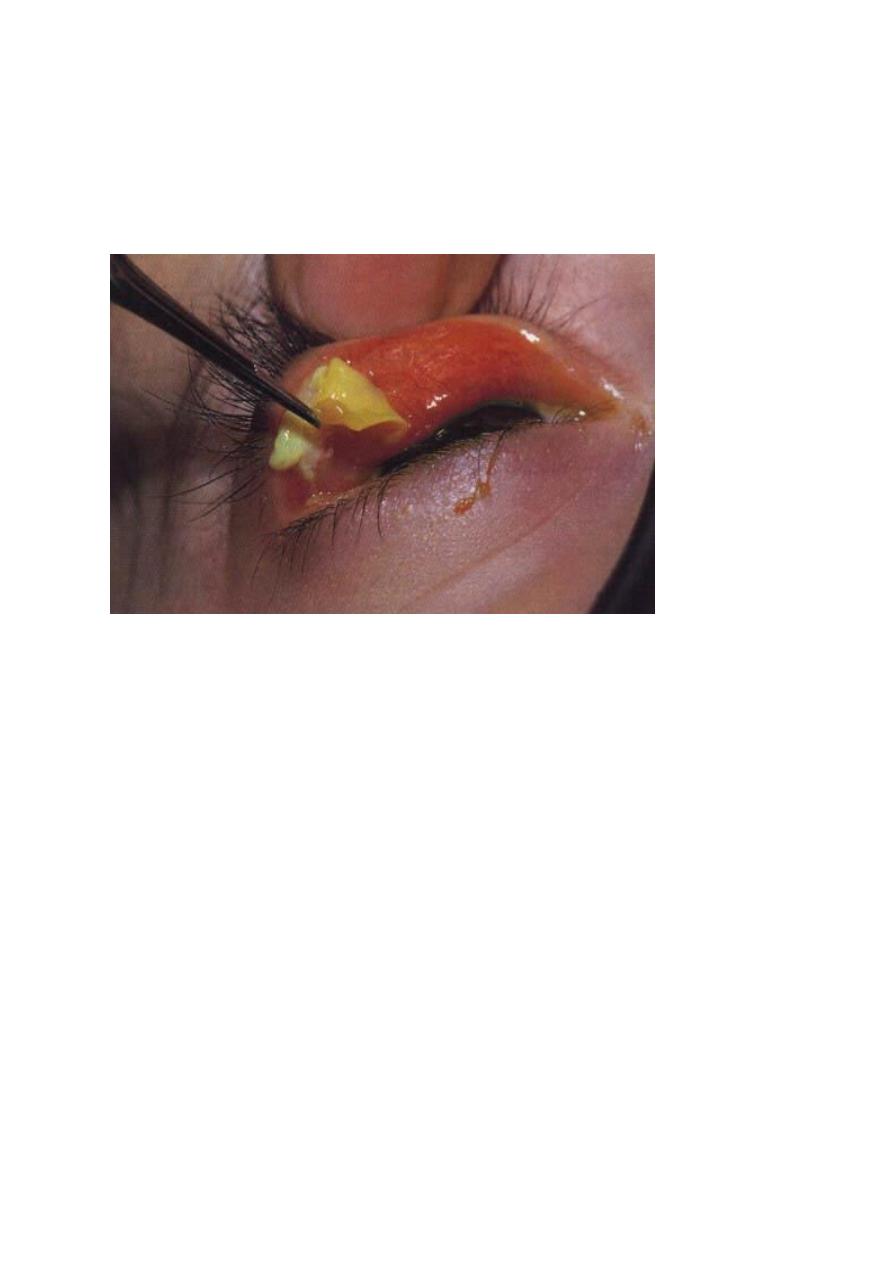
5
- Atopic conjunctivitis.
- Prolonged use of topical medications.
4- Conjunctival membranes:
a- Pseudomembranes:
Coagulated exudates adherent to the inflamed conjunctival epithelium, peeled off
leaving the epithelium intact (or healthy).
- Severe adenoviral infection.
- Gonococcal conjunctivitis.
- Steve-Johnson syndrome.
- Ligneous conjunctivitis, idiopathic, rare type of conjunctivitis.
b- True membranes:
When inflammatory exudate is permeates the conjunctival epithelium. Removal
of membranes may be accompanied tearing of the epithelium and bleeding.
- Beta-haemolytic Streptococci.
- Diphtheria.
5- Lymphadenpathy:
The upper and lower lids, the eyeball and other structures drain into the
preauricular and submandiblar lymph nodes. These lymph nodes are swollen in these
cases:
- Viral infections.
- Chlamydial infections.
- Severe Gonoccocal infections.
- Parinaud syndrome.

6
Laboratory Investigations:
There is no need to do routine investigations for every patient presented with
conjunctivitis unless has one of the following indications.
Indications:
- Severe purulent conjunctivitis.
- Follicular conjunctivitis (viral, chlamydial).
- Atypical conjunctivitis.
- Neonatal conjunctivitis.
Investigations:
1- Swabs: done after application of local anesthesia for Gram's stain, Giemsa.
2- Cultures.
3-Cytological: detects characteristic of cellular infiltration by immunological test.
4- Detection of viral or chlamydial antigens in conjunctival specimens.
Bacterial Conjunctivitis
1- Simple bacterial conjunctivitis:
It is a common disease, and usually it is self-limiting condition. Common causative
organisms are:
- Staphylococcus epidermidis.
- Staphylococcus aureus.
- Other like Strptococcus pneumoniae, H. influenzae.
Symptoms:
- Acute onset of redness.
- Grittines.
- Burning.
- Discharge.
- On morning, eyelids are stuck together due to accumulation of exudates during
the night.
- Both eyes are usually involved.
Signs:
- The eyelids are crusted and oedematous (mild oedema).
- Mucopurulent discharge.
- Beefy-red injection, maximally in the fornices.
- pseudoembranes in severe cases.
- Corneal involvement is uncommon.
* Blurred vision may occur due to mucus not due to corneal involvement.
Treatment:
- Usually resolves within 10-14 days and laboratory tests are not routinely
performed.
- Bathe all discharge away.
-Topical drops (Antibiotics): Chloramphenicol, ciprofloxacin, ofloxacin,
gentamicin, neomycin, tobramycin.

7
- Antibiotic ointments: it gives higher concentration for long period and usually
given at night because it causes blurred vision. e.g. chloramphenicol, gentamicin,
tetracydine, framycetin.
2- Neonatal bacterial Keratoconjunctivitis:
* bacterial conjunctivitis in neonate is one cause for Ophthalmia neonatorum
(any infection of the conjunctiva within the first month after delivery).
- Usually appears at 1-3 days of life.
- it is rare condition.
Signs:
- Hyperacute presentation.
- Chemosis.
- Pseudomembranes.
- Corneal involvement.
Treatment: Systemic and tropical.
Viral Conjunctivitis
1- Adenoviral keratoconjunctivitis:
- It is a highly contagious virus.
- Transmission is via respiratory or ocular secretion.
- Dissemination is by contaminated towels or equipments (e.g. tonometer: an
instrument used to measure the intraocular pressure).
- Incubation period is 4-10 days; it is an occupational hazard of ophthalmologists
(due to contamination of their hands with their pateints).
Conjunctivitis:
Presentation: acute onset of watery discharge, redness, discomfort and photophobia,
both eyes are affected in 60% of cases.
Signs:
- Eyelids are oedematous.
- Watery discharge.
- Mild chemosis to moderate.
- Follicular reaction.
- Subconjunctival haemorrhages.
- Pseudomembranes. and - Lymphadenopathy is tender.
Keratitis:
Multiple, corneal sub epithelial infiltration and opacification.
Treatment:
a- Avoid transmission following examination of patients:
- Washing of hands.
- Meticulous disinfection of ophthalmologic instruments.
- Infected hospital personnel should not be in contact with patients.
b- Medications:
i- For conjunctivitis:
- Spontaneous resolution occurs within 2 weeks.

8
- Antiviral agents are ineffective (has no role).
- Topical steroids are indicated only in very severe inflammations and when
Herpes simplex infection has been excluded. The treatment with steroids is
symptomatic and supportive (not used routinely).
ii- For keratitis:
- Topical steroids, which are indicated only if the eye is uncomfortable or
there is diminishing of the visual acuity by corneal sub epithelial infiltrates
and opacifications, Steroids should not be used till exclusion of Herpes
simplex infection.
Note: Steroids do not shorten the natural course of the disease but suppress the
inflammation and relief symptoms.
2- Herpes simplex conjunctivitis:
Conjunctivitis may occur in patients with primary Herpes simplex infection.
- when the person catches the infection for the first time it is primary, after treatment,
the virus get dormant in the trigeminal nerve ganglia. If for any reason, the person
gets decrease immunity, then secondary herpes infection is developed.
Signs:
- The eyelids and periorbital skin show unilateral herpetic vesicles, which may be
associated with edema.
- Watery discharge.
- Ipsilateral follicular reaction.
- Lymphadenopathy is tender.
- Keratitis is uncommon.
- Herpes simplex infection is very severe and it can lead to dendritic ulcer of the
cornea.
- No subconjunctival hemorrhage.
Treatment: Antiviral agent (as Acyclovir "Zovirax™") for 21 days to prevent
keratitis.
Chlamydial Conjunctivitis
1- Adult chlamydial Keratoconjunctivitis:
It is a sexually transmitted disease caused by the obligate intracellular bacterium
Chlamydia trachomatis.
- Patients are usually young and at least 50% have a concomitant genital infection
(cervicitis in ♀ or urethritis in ♂).
Mode of transmission:
- Autoinoculated from genital secretions.
- Eye to eye spread is rare.
Incubation period: 1 week.
Presentation:
Subacute onset of unilateral or bilateral mucopurulent discharge.
* Without treatment conjunctivitis persists for 3-12 months. So, in chronic
conjunctivitis we should think about Chlamydial Keratoconjunctivitis.

9
Signs:
- Eyelids are lightly oedematous.
- Mucopurulent discharge.
- Large follicles are formed at the inferior fornix.
- Lymphadenopathy (not tender).
- Keratitis is uncommon, if it occurs:
* Epithelial Keratitis.
* Subepithelial keratitis (opacities).
* Marginal infiltrates (circumferential, i.e. involvement of the limbus and the
periphery of cornea).
- Conjunctival scarring.
- Pannus (subepithelial corneal neovascular or fibrovascular membrane, i.e. affects
the cornea not the conjunctiva).
Diagnosis:
a- Clinical diagnosis.
b- Laboratory tests, e.g.:
i- Direct monoclonal fluorescent antibody microscopy.
ii- Enzyme immunosorbant assay.
Treatment:
a- Topical therapy: Tetracycline ointment 4 times\ day for 6 weeks.
b- Systemic therapy: One of the following:
i- Doxycycline: 100mg X 1 for 1-2 weeks.
ii- Tetracycline: 250mg X 4 for 6 weeks.
iii- Erythromycin: 250mg X 4 for 6 weeks.
2- Neonatal chlamydial conjunctivitis:
- The most common cause of neonatal conjunctivitis (ophthalmia Neonatorum).
- It may be associated with systemic infection, e.g. otitis, rhinitis or pneumonitis.
- It is transmitted from the mother genital tract during delivery.
Presentation:
The child is usually presented between 5 & 19 days after birth.
Signs:
- Papillary conjunctivitis (there is no follicular reaction as the lymphoid tissue
develops 3 months after delivery).
- Mucopurulent discharge.
Complications (if not treated):
There is Conjunctival scarring and superior corneal pannus.
Treatment:
a- Topical Erythromycin.
b- Oral Erythromycin, 250mg/kg body weight daily for 14 days.

10
3- Trachoma:
(Compare it with Adult Chlamydial Keratoconjunctivitis)
- It is an infection caused Chlamydia trachomatis.
- It is a disease of underprivileged populations with poor conditions of hygiene
(low socioeconomic status).
Transmission:
Common fly is the major vector, currently trachoma is the leading cause of
preventable blindness in the world.
Presentation: is usually during childhood.
Signs:
1- Follicular reaction.
2- Chronic conjunctival inflammation causes conjunctival scarring that involves
the entire conjunctiva but most prominent on the upper tarsus.
3- Keratitis: either * Superficial epithelial keratitis.
* Anterior stromal inflammation and pannus formation.
4- Progressive conjunctival scarring: if it is severe lead to:
* Destruction of lids.
* Trichiasis: Misdirection of eyelashes towards the cornea causing rubbing of
cornea, it is either true Trichiasis (due to affection of hair follicles) or pseudo
(due to entropion of lid margin).
* Entropion: the inward turning of the eyelid.
* Dry eyes, due to destruction of conjunctival goblet cells, accessory lacrimal
cells and lacrimal ducts of main lacrimal duct.
5- End-stage trachoma:
* Corneal ulceration (due to dry eye and Trichiasis). Superficial corneal ulcers
usually heal by regeneration so the cornea remains transparent, while deep
ulcers do not regenerate but heal by fibroblasts to fibrous tissue leading to
opacification, which lead to diminished visual acuity or even blindness in
severe cases.
World Health Organization (WHO) grading:
TF: Trachoma follicles (5 or more follicles in the superior tarsal conjunctiva).
TI:
Trachomatous intense inflammation diffusely involving the tarsal conjunctiva.
TS: Trachomatous conjunctival scarring.
TT: Trachomatous trichiasis touching the cornea.
CO: Corneal opacity.
Treatment of trachoma:
-indicated for stages I & II (TF & TI) only, as there is no benefit from treating
stages III, IV &V (there is no active inflammation).
- Preventive measures: strict personal hygiene, especially washing the face of
young children (single face wash at the morning is enough to prevent the
infection).
- Topical Tetracycline or Erythromycin eye ointment plus Single dose of systemic
erythromycin.

11
Allergic conjunctivitis
1- Acute allergic conjunctivitis (Allergic rhinoconjunctivitis):
- The most common type of eye allergy.
- It is a hypersensitivity reaction (type I) to specific airborne antigens.
- Usually there is associating nasal symptoms (so it is called rhinoconjunctivits) that
is thought to be a result of one or more of the following fact:
a- Direct effect of the allergen on the nasal mucosa and conjunctiva.
b- We have nasolacrimal drainage, so the excessive tears produced are drained to
the nose.
c- As both of them (the conjunctiva and nasal mucosa) are supplied by
pterygopalatine ganglia, so the stimulation of one of them will lead to stimulation
of the other.
Presentation:
Acute, transient attacks of slightly red, itchy and watery eyes associated with
sneezing and a water nasal discharge.
Signs:
- Mild to moderate lids oedema (as there is inflammation of the palpebral part of
conjunctiva that liberates mediators that cause collection of fluids).
- Periorbital oedema in severe cases.
- Milky or pinkish appearance of conjunctiva as a result of oedema and injection.
- Mild papillary reaction in the upper tarsal conjunctiva.
Treatment:
Is either topical mast cell stabilizer e.g. nedocromil & lodoxamide, or topical
antihistamine e.g. levocabastine & azelastine.
* Only in very rare and severe cases we need topical steroids.
2- Vernal keratoconjunctivitis (spring catarrh):
- It is a recurrent, bilateral, external, ocular inflammation affecting children and
young adults.
- More common in male than females.
- Vernal keratoconjunctivitis is an allergic disorder in which IgE and cell-mediated
immune mechanisms play an important role (hypersensitivity reactions type I & IV).
- 3/4 of patients have associated atopy and 2/3 has close family history of atopy.
- Atopic patients often develop asthma and eczema in infancy.
- The onset of vernal keratoconjunctivitis is usually after the age of 5 years (5-8y)
and the condition eventually resolves around puberty, only rarely persisting beyond
the age of 25 years.
- As its name suggests (seasonal basis), the peak incidence of symptoms occur
between April and August but many patients have year-round disease.
- The condition is more common in warm, dry climate and less frequently in colder
climates.
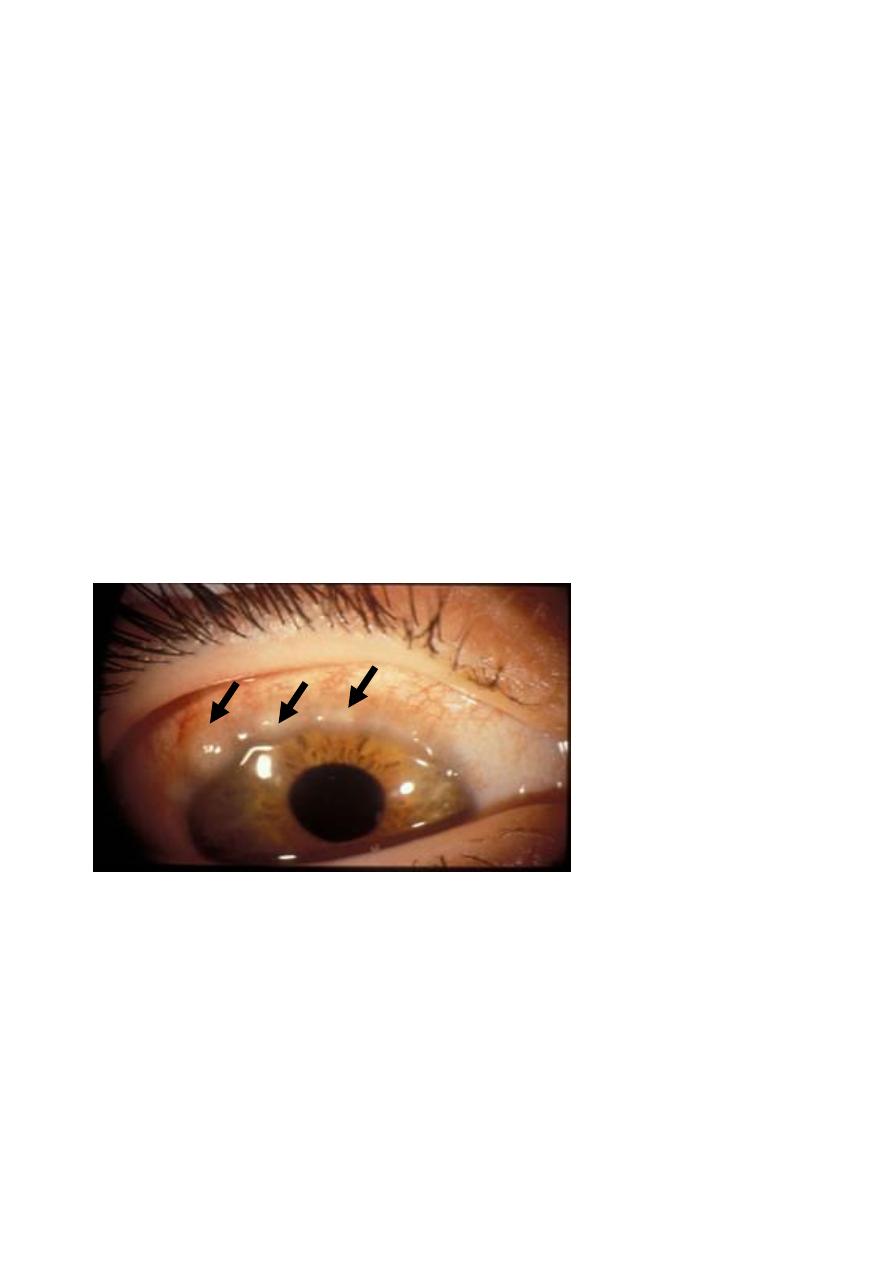
12
Clinical features:
The main symptoms are: Intense ocular itching, Lacrimation, Photophobia, Foreign
body sensation, Burning, Thick mucus discharge and Ptosis which is also occurs (it is
a mechanical ptosis as it occurs due to chronic inflammation and oedema that causes
heaviness and increased weight of the eyelid).
There are three main types (according to anatomical distribution of vernal disease):
a- Palpebral, b- Limbal and c- mixed.
Limbal vernal keratoconjunctivitis is more common in dark-skinned races,
palpebral vernal keratoconjunctivitis is more common in lighter-skinned races and it
is usually more severe.
Signs:
For conjunctivitis:
* For palpebral vernal keratoconjunctivitis, the signs in chronological order:
- Conjunctival hyperaemia.
- Diffuse papillary hypertrophy mostly on the superior tarsus (tarsal conjunctiva).
- Enlarged of papillae ends in flat-topped polygonal appearance reminiscent of
cobblestones.
- In severe cases, the connective tissue septa rupture, giving rise to giant papillae.
* For limbal vernal keratoconjunctivitis:
Trants dots
- It is characterized by mucoid nodules that have a smooth round surface.
- Discrete white superficial spots (Trantas dots); which are composed of collections
of inflammatory predominantly eosinophils, are found scattered around the limbus.
* For mixed vernal keratoconjunctivitis:
- There are papillary reactions and Trantas dots.
For keratitis: (in chronological fashion)
- Punctate keratopathy (epithelial erosions, micro erosions), it is the earliest finding.
- Macro erosions (result of continued epithelial loss, i.e. small ulcers).

13
- Plaque (macro erosions coated by layers of mucus which cannot be wetted by tears
and resists epithelization).
- Subepithelial scarring (sign of previous severe corneal involvement), it occurs due
to persistent inflammation that prevents healing).
- Pseudogerontoxon, which resembles arcus senilis. It is seen in the outline of
previously inflamed limbus (occurs if the epithelial scarring and opacification are in
the periphery of the cornea).
Treatment:
1- Topical steroids: (its use is mandatory)
- As the patients will not cure until around puberty by any drug, so we should use
weak steroids as fluorometholone or Clobetasone. Potent topical steroids likes
dexamethasone, betamethasone or prednisolone should be avoided as their corneal
penetration and their risk to increase IOP and causing cataract is more than weak
steroids.
- It should be of short course.
2- Mast cell stabilizers:
nedocromil 0.1% drops *2 daily
or lodoxomide 0.1% drops *4 daily.
or sodium cromoglycate 2% *4 daily
They are not effective as steroids in controlling acute exacerbation.
3- Acetylcyseine 5% drops *4 daily, as treatment of early plaque formation
(mucolytic).
4- Topical cyclosporin A: used in steroids resistant cases.
5- Debridement: of early mucus plaques to get speed repair of persistent epithelial
defect, done under topical anesthesia with cotton-tipped applicator.
6- Lamellar keratectomy: For densely adherent plaques or subepithelial scarring, and
sometimes we may need corneal replacement (corneal graft).
7- Supratarsal injection of steroids: it is very effective in patients with severe disease
and Giant tarsal papillae. It is used to avoid ocular side effect of topical medications.
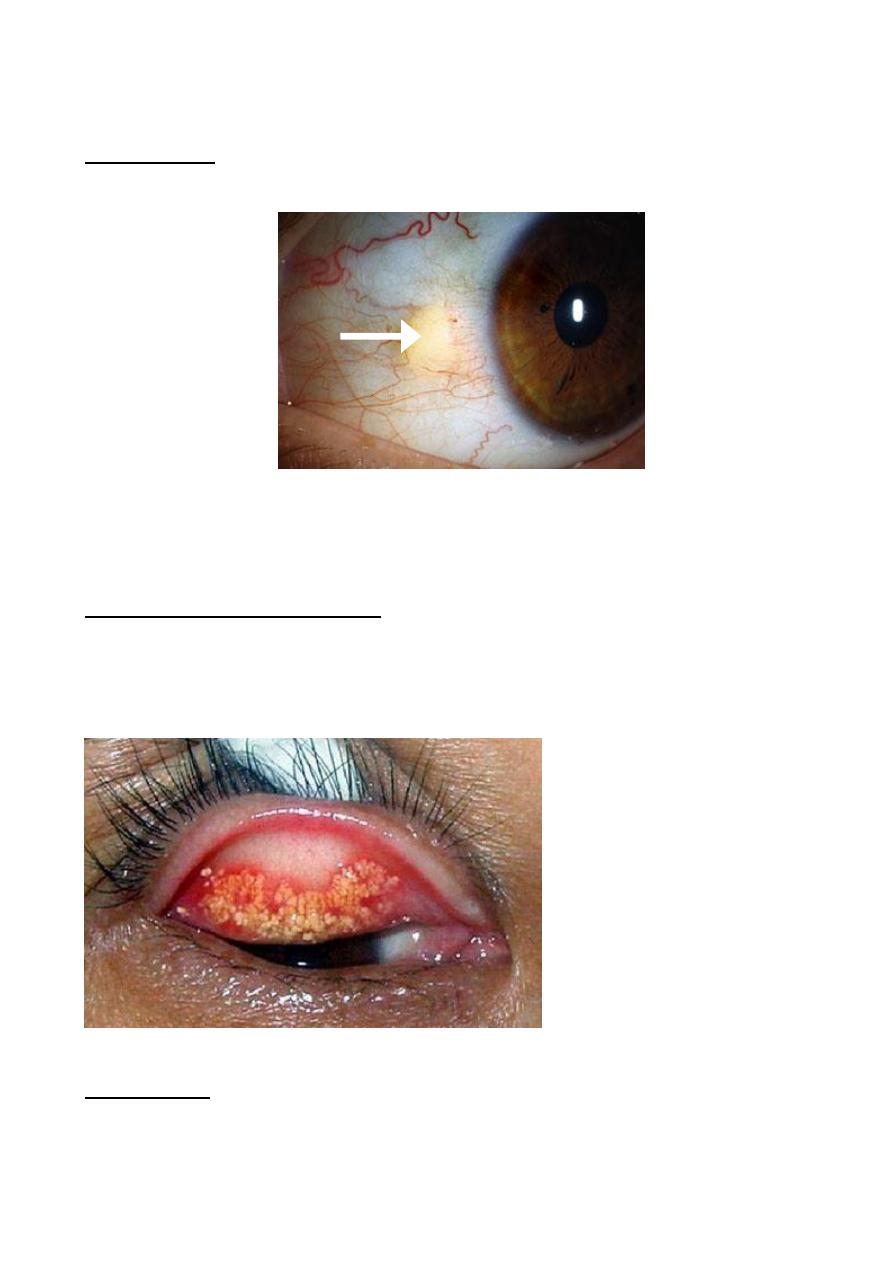
14
Conjunctival Degenerations
1- Pinguecula:
It is an extremely common lesion which consists of a yellow-white deposit on the
bulbar conjunctiva adjacent to the nasal or temporal aspect of the limbus and it is
usually asymptomatic.
Histology: There is degeneration of the collagen fibers of the conjunctival stroma,
thinning of the overlying epithelium and occasionally calcification.
Some pinguecular may enlarge very slowly but surgical excision is seldom required.
(usually, it need no treatment)
2- Concretions (ocular lithiasis) :
- They are small yellow-white deposits.
- Commonly present in the palpebral conjunctiva of the elderly.
- Also in patients with chronic meibomian gland disease.
- Usually asymptomatic, but occasionally causes foreign body sensation when erode
through the epithelium.
Treatment: They can be easily removed with a needle.
3- Pterygium:
- It is a triangular sheet of conjunctival fibrovascular tissue invades the cornea.
- Occurs in patients who have been living in outdoor, hot climates.
- May represent a response to chronic dryness and exposure to the sun.
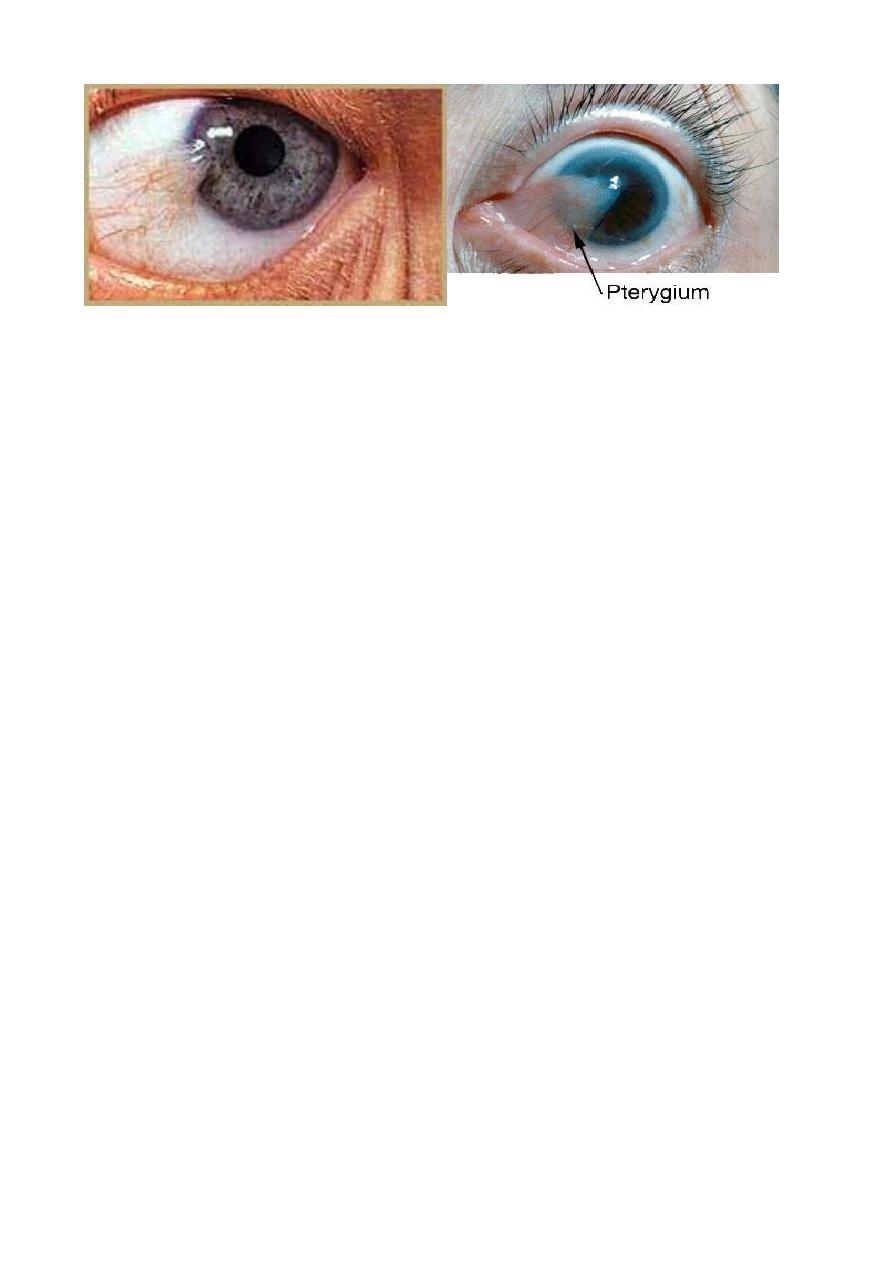
15
Signs:
a- Small, grey, corneal opacities near the nasal limbus.
b- Then, the conjunctiva overgrows these opacities and progressively invades onto
the cornea in a triangular fashion.
c- A deposit of iron (Stocker line) may be present in the corneal epithelium anterior
to the advancing head of the pterygium.
* Usually asymptomatic.
Treatment:
a- Surgical excision: indicated only in the following cases: i- If it is threatening the
visual axis. ii- Severe irritation. iii- For cosmetic reason.
b-Lamellar keratoplasty: required if the visual axis is affected by opacification.
Surgical excision, it is an easy procedure but should be avoided unless there is
indication because the recurrent rate is high (about 40%) and the recurrent ptrygium
is uglier, rapidly progress and causing more severe symptoms.



